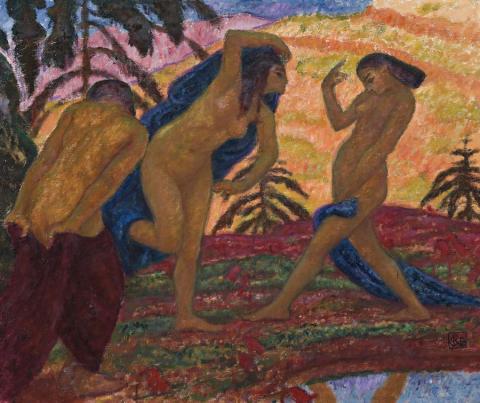MAENADS, c.1913-21
RUPERT BUNNY
oil on canvas
54.5 x 65.5 cm
signed with monogram lower right: RCWB
inscribed verso: Maenads
label attached verso: Lucien Lefebvre-Foinet, Paris
label attached verso: John Thallon, Melbourne
The Estate of The Lady Casey, Melbourne
Exposition Rupert Bunny, Galeries Georges Petit, Paris, 2–15 March 1922, cat. 19 (as'Ménades')
Salon d'Automne, Paris, 1 November – 14 December 1924, cat. 266
Exhibition of Paintings by Rupert C.W. Bunny, Hogan's Art Gallery, Melbourne, 23 September – 10 October 1936, cat. 16 (as 'Maenado')
Contemporary Art Group, Melbourne, 10–21 August 1937, cat. 12
Inaugural Exhibition, Contemporary Art Society (of Australia), National Gallery of Victoria, Melbourne, 6–25 June 1939, cat. 103
Thomas, D., Rupert Bunny, Lansdowne Press Pty Ltd, Melbourne, 1970, cat. 0255
When Rupert Bunny exhibited his new mythological decorations in Paris at the Georges Petit Galleries in March 1922, the exhibition was said to have 'caused quite a sensation'.1 'One eminent critic [it was reported] is of the opinion that 'it has raised the prestige of the Gallery'.2 To cause a sensation in Paris is an achievement in itself, Maenads, c.1913-21 being one of forty-four paintings that created it. Inspired by Greek mythology, it included some of the best paintings he had done, now treasured in our leading public collections and by private collectors alike. Fore most among the many are The Rape of Persephone, c.1913 (National Gallery of Australia, Canberra), Hercules in the Garden of the Hesperides (National Gallery of Victoria, Melbourne), Circe (Geelong Art Gallery, Victoria), and The Muses Plucking the Wings of the Sirens, c.1922 (private collection). Nausicaa was purchased from the 1922 exhibition by the French State and is now in the Musée Départemental de l'Oise, Beauvais.
Maenads, c.1913-21 is one of the most striking and individual works in Bunny's oeuvre, a star among those later mythological paintings when Bunny was his most adventurous self. The wild primitivism of the forms and audacious colours show the impact of the Ballets Russes, colours hot, dry, and bold, designs boldly rhythmic. While Nijinsky's dancing based on the profiling of dancers seen on ancient Greek vases inspired many of these paintings, it is the primitive that is so striking in Maenads. There is also the influence of Henri Matisse and the other Fauves.3 While Bunny's accumulative gifts were extraordinary Maenads is one of the most individual of his mythological decorations. Writing about the then forthcoming exhibition, he said, 'I am doing a show of rich decorative and even fantastic compositions. Not having touched a brush for so long during the war, I came to the conclusion that painting should be as rich, and beautiful as embroideries and oriental stuff; and that the artist has the right to do subjective work whenever he feels like it. In any case, I am just letting myself go and giving my imagination and sense of colour a free reign.'4
The subject had a particular appeal for Bunny. Maenads or bacchantes were the 'mad women' votaries of Dionysus, Greek god of wine (the Roman Bacchus). The frenzy of their dancing gave Bunny the opportunity to depict that individuality of movement that the Ballets Russes introduced to French theatre. Dance had been a feature of a number of his colour monotypes exhibited in Paris in 1921 - as in Danse de Bacchantes (Art Gallery of South Australia, Adelaide), and Maenads (Charles Sturt University Art Collection, Wagga Wagga). In 1939 Maenads was one of the three paintings Bunny chose to represent him in inaugural exhibition of the Contemporary Art Society of Australia.
1. Fry, E.M., 'Australian Artists Abroad', The Home, 1 September 1922, p. 2
2. Fry added, 'The significance of the compliment will be realised when it is understood that the Petit Gallery is the largest and wealthiest in Paris, and has made more artistic reputations than any other picture gallery in the world.'
3. Maenads was shown at the Paris Salon d'Automne, in November 1924
4. Quoted in 'Rupert Bunny and Webb Gilbert', Art in Australia, new series, no. 1, February 1921, p. 41
DAVID THOMAS
